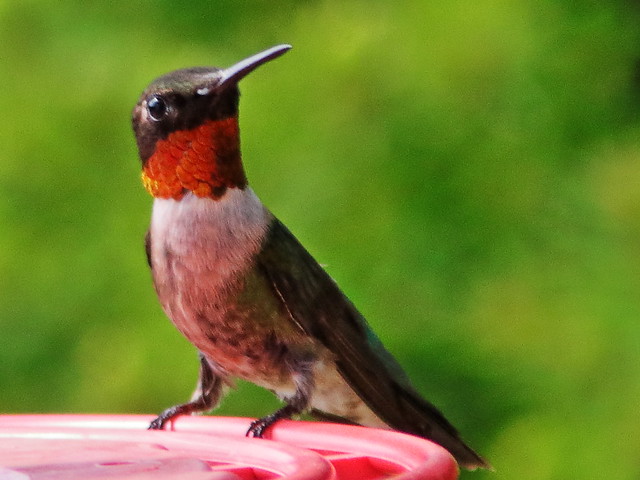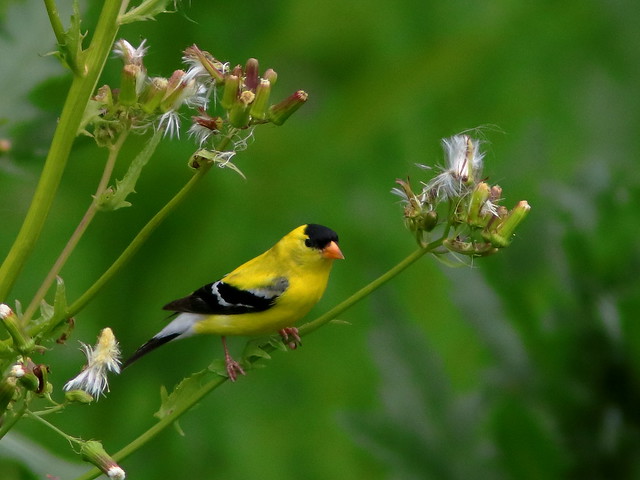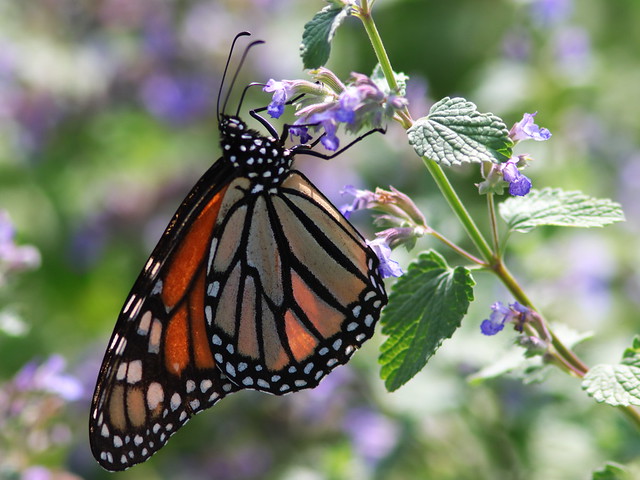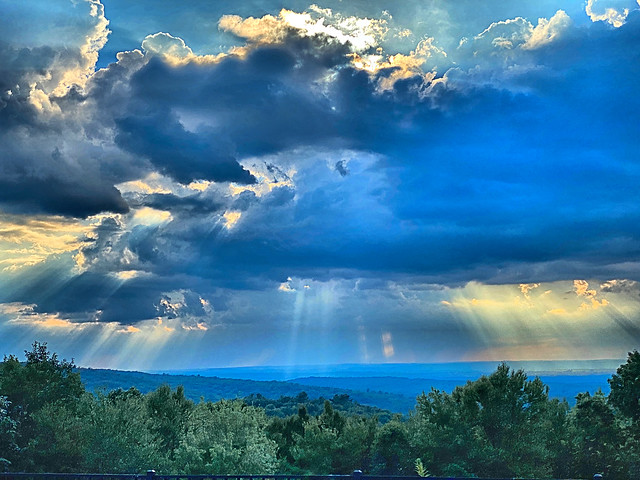Connecticut has been experiencing unusually hot and dry weather the past two weeks, with daily temperatures often higher than those in Florida, reaching into the mid- to high 90s°F (35-36°C) with heat indices of 100- 104°F (38-40 °C). The bird bath is visited frequently and the hummingbird feeder empties out quickly.
We keep the sugar concentration low (4 parts water to 1 sugar) to provide adequate hydration for the little birds. Only female Ruby-throated Hummingbirds visited the feeders from spring into late July. Their numbers increased and were augmented by immature offspring with duskier plumage. Adult males do not participate in care for the young but often continue to defend their territory. Males migrate south early, beginning in late summer. Females and immature birds exit about 2-3 weeks later.
Two are company...
...and three's a crowd, but look who's coming!
A mob of 8 to 10! I never got more than six to fit in the frame at one time:
Then, on July 29, a single adult male appeared:
While several female and immature hummingbirds often fed together, the male threatened or chased away any other visitors:
The throat patch (gorget) of the male is actually black. It contains no red pigment. Its color is created by iridescence-- refraction and reflection of light from microscopic mirror-like scales on the specialized feathers. The backs of males and females reflect a metallic green:
American Goldfinches continue to gather fluffy down to line their nests. Now the work is mostly being done by males, leading me to assume that females are incubating eggs:
On July 26, a female White-tailed Deer reclined in one shady patch, in clear view for over 6 hours, from 10:00 AM to 4:30 PM:
She may have simply been resting, but we suspected that she was in labor. She moved to a sunny spot a few feet away before disappearing:
On July 31 we caught a glimpse of a very young fawn which had been hiding in deep vegetation until the parent approached. We wondered whether this doe might be the same one we had seen earlier:
The fawn followed her and suckled as they disappeared into the trees. I shot blindly into the dark undercover and was lucky to obtain only a partial view of the infant:
On August 8, we saw this older fawn with its mother. It was possibly "Bambi" which we first photographed as a wobbly infant just one month previously:
Two days later the older fawn was eating the fresh leaves which sprouted around a felled maple:
White-tail fawns begin to forage when about 2 weeks old and cannot survive if deprived of mothers' milk before age of 10 weeks, but are usually weaned at 12-16 weeks. It is said that fawns born later than June in northern states may not be adequately developed to survive the winter.
A Monarch butterfly, the first I have seen here, appeared on the catmint (variety: Cat's Meow Catmint, Nepeta faassenii, similar to catnip, Nepeta cataria, but it does not stimulate cats). The migratory population of this butterfly species has just been declared Endangered. Any kind of butterfly is a treat-- some days I do not see a single one:
The swimming pool has provided entertainment for the younger crowd. Two of our granddaughters with our son and his wife flew in from Texas and visited and enjoyed short drives to tour Boston and Mystic, Connecticut. The lawn shows the effects of the heat and drought:
Rain threatened and fell over Hartford, eleven miles to the west, but we remained dry:
As expected, the sunset was gorgeous:
= = = = = = = = = = = = = = =
Skywatch Friday
Weekend Reflections
Saturday's Critters
BirdD'Pot
All Seasons
Wordless Wednesday (on Tuesday)
My Corner of the World
________________________________________________
Please visit the links to all these posts to see some excellent photos on display
________________________________________________

































What a beautiful area for you to live in, and that house looks like a mansion. Enjoyed all the photos and information on the Hummingbirds and White-tailed Deer. It's been a few years since I've spotted a Monarch. Our summer is beginning to cool down as yours is beginning to heat up. Hopefully your heat wave will pass soon.
ReplyDeleteThat house is amazing! I love the critters. Great photos.
ReplyDeleteI love the hummingbirds and the fawns, although I would not want to be a deer mom.
ReplyDeleteStunning skies.
ReplyDeleteSo beautiful! Thank you very much
ReplyDeleteI loved all the hummingbird photos. Perfectly captured. Their behavior is so interesting!
ReplyDeleteThe birds are really pretty, we have green and yellow finches here but not hummingbirds.
ReplyDeleteThis was a wonderful post. The doe: even though there is a herd of deer behind me, I never get close enough to notice: is it only your doe that has that dark smudge on its muzzle? Or all of them? It looks as if you were able to follow the growth of one fawn. What a treat! The hummers are irrisistible.
ReplyDeleteGood question, Andree. All the older deer have dusky muzzles, but the extent and the depth of darkness varies. Males often have darker face markings then the females. In winter their coat changes from reddish to darker gray and the face markings may be black. I've look for pattern variations which may help me identify specific individuals, but so far not succeeded.
DeleteHello Ken,
ReplyDeleteYour hummingbirds photos are amazing. I use the same recipe for the sugar water in my hummer feeders. Cute Goldfinch photos. Sweet captures of the deer. Your family must really enjoy the pool, gorgeous sky captures and views.
Thank you for linking up and sharing your post. Take care, have a great weekend. PS, thank you for leaving me a comment.
How amazing to see the doe...probably in labor and then to see the young fawn. That really is a miracle of life. Love the sky photos too and the hummers. Enjoy your weekend!
ReplyDeleteWonderful photos! That pool looks fun.
ReplyDeleteHello Ken,
ReplyDeletewe have the same temperatures in Germany, but not such beautiful hummingbirds ;-) Your photos are great again. I wish you a good time with your family.
Kind regards - Elke (Nature Thursday)
The bird feeder shots are so great. Alas for me mine is not nearly as successful!! The deer shots are lovely too. Thanks for joining in #allseasons
ReplyDeleteOh ! I love hummingbirds, but somehow I find them tricky to capture alike other small birds. The reflection of cloudy sky in the lake is brilliant shot. Thanks for sharing with Garden Affair.
ReplyDeleteAnother terrific post, Ken!
ReplyDeleteYou attracted quite a hummer crowd! It must be a little frustrating to see the rain a few miles away and then not get any. Hopefully, you'll get some moisture soon.
Have a great new week!
Another series of fabulous shots. Love the hummingbird, fawn and your family pics. So much fun with your grands.
ReplyDeleteSou sweet photos birds and animals.
ReplyDelete